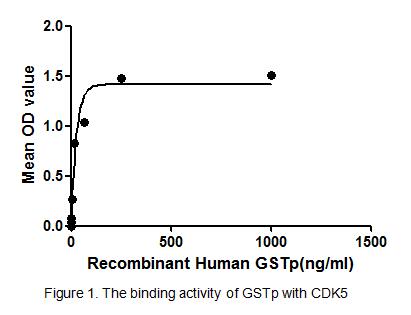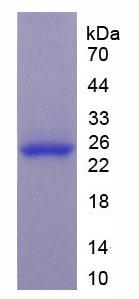Active Glutathione S Transferase Pi (GSTp) 

GSTP1; GST-P1; DFN7; FAEES3; GST3
- UOM
- FOB US$ 220.00 US$ 550.00 US$ 1,100.00 US$ 3,300.00 US$ 8,250.00
- Quantity
Overview
Properties
- Product No.APB090Hu01
- Organism SpeciesHomo sapiens (Human) Same name, Different species.
- ApplicationsCell culture; Activity Assays.
Research use only - DownloadInstruction Manual
- CategoryEnzyme & KinaseMetabolic pathwayTumor immunityHepatology
- Buffer Formulation20mM Tris, 150mM NaCl, pH8.0, containing 1mM EDTA, 1mM DTT, 0.01% SKL, 5% Trehalose and Proclin300.
- Traits Freeze-dried powder, Purity > 95%
- Isoelectric Point6.2
Sign into your account
Share a new citation as an author
Upload your experimental result
Review

Contact us
Please fill in the blank.
Activity test

GSTp (Glutathione S-transferase P) is an enzyme that plays an important role in detoxification by catalyzing the conjugation of many hydrophobic and electrophilic compounds with reduced glutathione. GSTP1 is identified as a CDK5 (Cyclin dependent kinase-5) regulatory protein, and is thought to regulates negatively CDK5 activity via p25/p35 translocation. Thus a binding ELISA assay was conducted to detect the interaction of recombinant human GSTp and recombinant human CDK5. Briefly, GSTp were diluted serially in PBS, with 0.01%BSA (pH 7.4). Duplicate samples of 100ul were then transferred to CDK5-coated microtiter wells and incubated for 2h at 37°C. Wells were washed with PBST and incubated for 1 h with anti-GSTp pAb, then aspirated and washed 3 times. After incubation with HRP labelled secondary antibody, wells were aspirated and washed 3 times. With the addition of substrate solution, wells were incubated 15-25 minutes at 37℃. Finally, add 50 µL stop solution to the wells and read at 450 nm immediately. The binding activity of of GSTp and CDK5 was shown in Figure 1, and this effect was in a dose dependent manner.

Usage
Reconstitute in 20mM Tris, 150mM NaCl (pH8.0) to a concentration of 0.1-1.0 mg/mL. Do not vortex.
Storage
Avoid repeated freeze/thaw cycles. Store at 2-8°C for one month. Aliquot and store at -80°C for 12 months.
Stability
The thermal stability is described by the loss rate. The loss rate was determined by accelerated thermal degradation test, that is, incubate the protein at 37°C for 48h, and no obvious degradation and precipitation were observed. The loss rate is less than 5% within the expiration date under appropriate storage condition.
Increment services
-
 BCA Protein Quantification Kit
BCA Protein Quantification Kit
-
 Molecular Mass Marker for Protein
Molecular Mass Marker for Protein
-
 Monoclonal Antibody Customized Service
Monoclonal Antibody Customized Service
-
 Polyclonal Antibody Customized Service
Polyclonal Antibody Customized Service
-
 Protein Activity Test Experiment Service
Protein Activity Test Experiment Service
-
 Electrophoretic Mobility Shift Assay (EMSA) Experiment Service
Electrophoretic Mobility Shift Assay (EMSA) Experiment Service
-
 Buffer
Buffer
-
 Lentivirus Packaging Experiment Service
Lentivirus Packaging Experiment Service
-
 Adenovirus Packaging Experiment Service
Adenovirus Packaging Experiment Service
-
 Real Time PCR Experimental Service
Real Time PCR Experimental Service
-
 Spike RBD Protein (S-RBD)
Spike RBD Protein (S-RBD)
-
 Protein G
Protein G
-
 Protein A
Protein A
Citations
- Glutathione S-Transferase P1 Correlated with Oxidative Stress in Hepatocellular CarcinomaPubMed: PMC3619117
- Human Glutathione S-Transferase Enzyme Gene Polymorphisms and Their Association With NeurocysticercosisPubmed:27021019
- 3D Printing of Differentiated Bone Marrow Mesenchymal Cells as a New Method for Liver Tissue Engineeringart00007
- Comprehensive proteomic profiling of patients' tears identifies potential biomarkers for the traumatic vegetative statePubmed:30019218
- Attenuating effect of Indole-3-Carbinol on gold nanoparticle induced hepatotoxicity in rats
- The Role of Glutathione S-Transferases in Pleomorphic Adenomas of the Salivary Glands









